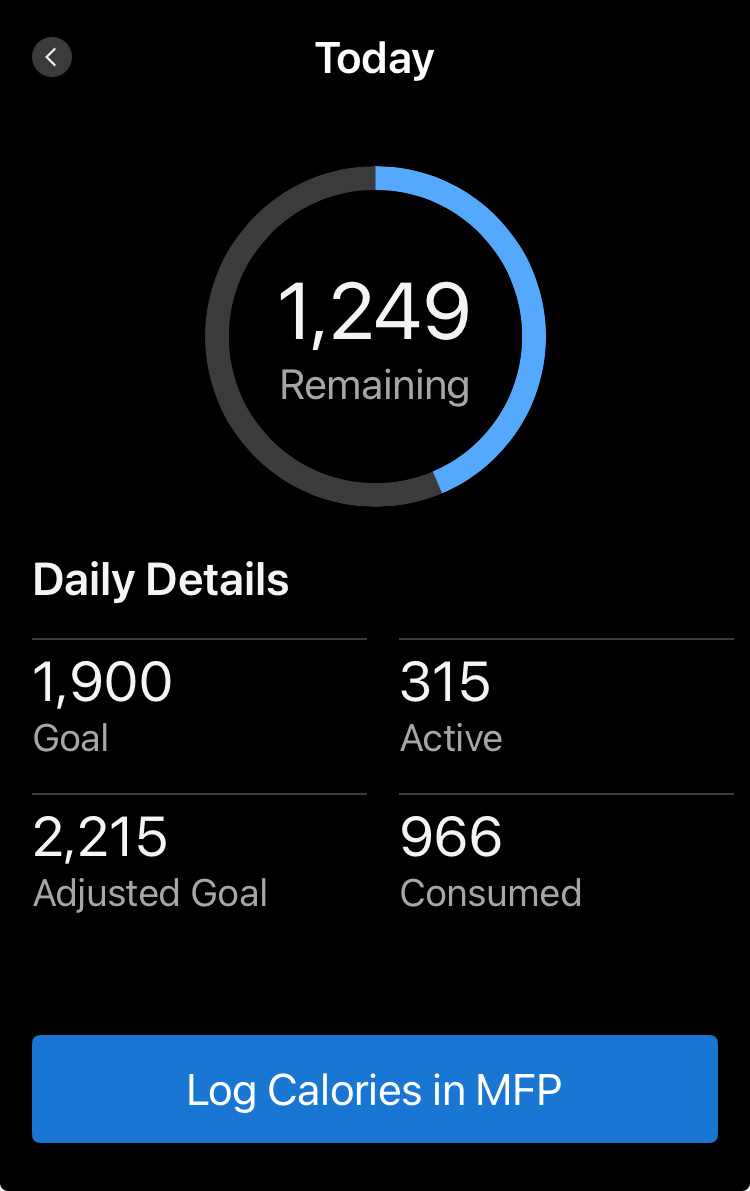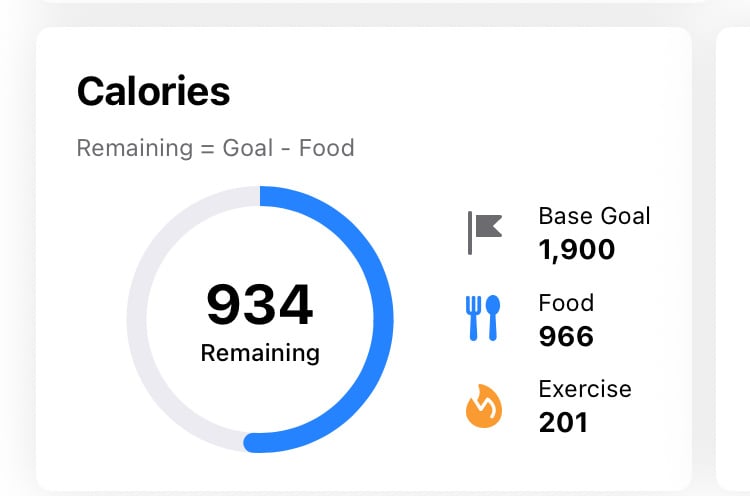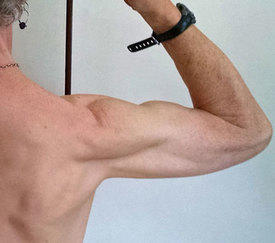Garmin and exercise calories

I have successfully connected my fitnesspal and Garmin. My fitnesspal is set to not adjust my daily calorie goal based on my exercise calories, but Garmin appears to make that adjustment automatically. Is there a way to make it not do so?
Replies
-
Could you provide a screenshot - why do you think Garmin is adjusting anything?
Normally, Garmin does nothing except transmit your TDEE and exercise sessions to MFP. MFP is the one deciding what to do with that info: adding your exercise sessions to your diary, adjusting your calorie goal (or not).
0 -
Top is Garmin, bottom is MFP.
0 -
Ah, I see the issue. So the calorie goal in MFP is correct and not adjusting after exercise. But the calorie goal shown in Garmin is incorrect.
I have a Garmin myself and for me, with calorie adjustments active, the number is always incorrect too.
I think this might be a case of looking at MFP for your calorie intake and ignoring what Garmin says? It's either an error on Garmin's side or perhaps MFP is sending wrong numbers back to Garmin. In both cases, I don't have huge hopes for a solution since it's been wrong as long as I've been using MFP (2019).
Edit: looking at your numbers again, at least yours make sense and it simply seems that Garmin isn't taking into consideration the setting for deactivating calorie adjustments - perhaps MFP isn't sending over that info and/or Garmin isn't willing to receive it. My numbers don't add up at all!
0 -
Frustrating. But thanks for taking a look.
0 -
I would suggest you stick to the calorie intake goal, may be change it or increase if you know you have burned certain calories by an exercise. For example, you know you have burned 400 calories by jogging, then may be on that day you can increase you calorie intake. Garmin will increase calorie intake on how much you have been busy on a day, i would not go by that, most of the trackers tend over estimate calories burned.
So with out confusing you more, just stick to your calories goal, unless you have burned some through a workout.
0 -
Sure, fitness trackers can over-estimate calories burned. They can also under-estimate calories burned.
If I'd taken your advice, and ignored activity calories unless very active, I'd have lost weight at a health-threateningly fast rate. I know that's not true for everyone. Unusual, yes; unique, not. Consequently, I wouldn't base my advice to others on my personal, individual experience or generic internet stories about fitness trackers. That could be a fail in either direction.
Every individual needs to run their own experiment, logging carefully for 4-6 weeks (or a minimum of one full menstrual cycle, for those who have them) then comparing average scale results to expected/intended results. That provides enough information to adjust - personalize - calorie goal if necessary. The personal adjustment may be up, down, or not necessary.
It's as much about an individual person varying from the statistical averages trackers base estimates on, as it is about inherent universal accuracy or lack of accuracy of the tracker.
I've been logging/tracking weight and calories for nearly 10 years, about a year of loss then successful maintenance since. I've been wearing a Garmin nearly 24x7 since August 2018, 2 different Garmin models, in fact. They're Garmin models that others here have said estimate calorie expenditure quite accurately for them.
Over the past year, Garmin thinks my average calorie expenditure has been 1635 calories daily. I've been eating 1850 calories plus exercise calories (200-300 extra most days). I don't log extra calories eaten "just in case" either. I even throw in some way over goal indulgent days occasionally. I don't have a precise average number, but I've eaten well over 2000 calories on average daily.
So, on average, if Garmin were correct, I would've gained around 42 pounds in the last year, at least. On June 22 last year, I weighed in at 133.2 pounds. Today, I weighed in at 133.0 pounds. There's no big surprise in the middle, just some mild, normal ups and downs.
Fitness trackers can be pretty amazing, when worn 24x7. They can be pretty close for a decent number of people. But they can be off in either direction for others. IMO, everyone needs to run their own personal experiment for enough weeks to see multi-week average trend results, then adjust if necessary. Faster weight loss isn't necessarily better weight loss: It can also be riskier weight loss.
0 -
I walk counting steps over the whole day. Fitness pal wants minutes. How can I change
0 -
Set your activity level in MFP based on your average/typical steps per day. Don't try to record walking that's part of daily life routine as exercise. That would be my advice.
Usually, if someone takes an intentional continuous (or mostly continuous) walk for exercise purposes, they will know a time and pace or distance. Those can be more easily logged as exercise.
Walking that's part of job, chores, errands, etc. - reflect that in MFP activity level setting.
It would theoretically be possible to translate steps into approximate miles and maybe derive a calorie estimate from that using other outside calculators, but it's iffy.
A thing I should've said in my PP on this thread, which is more relevant to OP's question and not so relevant to yours:
If a person takes very long, slow walks - like hours at a very casual stroll - it becomes increasingly likely that the basic MFP calorie estimates for walking at that slow speed will produce an unrealistically high calorie total. For normal walks that are a little more brisk, and shorter, not as big a deal. The issue has to do with MFP's underlying method of accounting for exercise calories, and generalizes beyond walking . . . but there aren't that many other things that people tend to do for long durations at very low intensity, then log as exercise. I can explain that more fully if anyone wants that, but at more moderate durations it really isn't a huge thing arithmetically IMO.
0 -
Thanks for the helpful comments. Like Ann,, I have been tracking for some time and have a pretty good sense of my individual calorie needs relative to my activity. So my question was really about how how to get the data to present the way that I want to, but it looks like Garmin is just not going to do that for me.
1 -
I used my Garmin with great success (over time) in tracking activity calories, and I wore it 24x7 during the diet and a HR chest strap during workouts. It was as valuable to me in tracking activity calories as was MFP in tracking food. But I didn't connect the two for this reason. I set a food intake target and an activity target and stuck to them, individually, and adjusted as neccessary along the way. The main reason I did it this way is that while during the diet it was the combination of restrictive eating and extra activity to lose the weight, at the end of my diet my only goal was to be active "enough" to eat normally again like before the desk job. So it was important for me to track all activity, exercise and NEAT, to get a handle on what I was burning and what was the threshold I needed to hit to just eat again eventually. And that was easier to do by tracking each seperately. Something I never had to do before the desk job because I was active enough naturally (more demanding jobs and lifestyle). Now I use my Garmin just to gauge different routines that I might try relative to all of my known routines. I know now what my various routines burn and how much NEAT I generally get and just how active I need to (intentionally) be per day to just eat.
0
Categories
- All Categories
- 1.4M Health, Wellness and Goals
- 397K Introduce Yourself
- 44.2K Getting Started
- 260.9K Health and Weight Loss
- 176.3K Food and Nutrition
- 47.6K Recipes
- 232.8K Fitness and Exercise
- 456 Sleep, Mindfulness and Overall Wellness
- 6.5K Goal: Maintaining Weight
- 8.7K Goal: Gaining Weight and Body Building
- 153.3K Motivation and Support
- 8.3K Challenges
- 1.3K Debate Club
- 96.5K Chit-Chat
- 2.6K Fun and Games
- 4.5K MyFitnessPal Information
- 16 News and Announcements
- 18 MyFitnessPal Academy
- 1.4K Feature Suggestions and Ideas
- 3.1K MyFitnessPal Tech Support Questions



